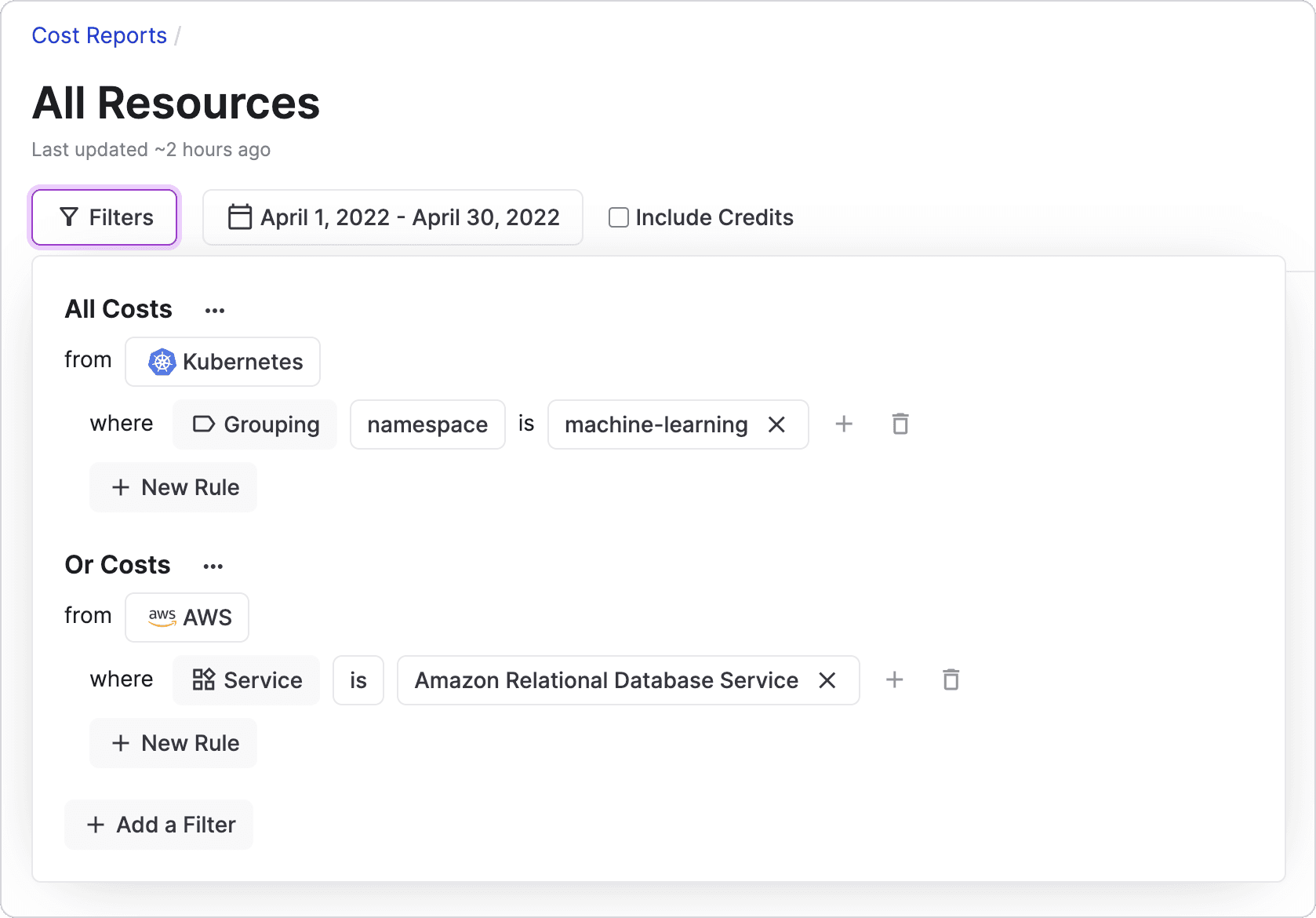Vantage Launches Support for Kubernetes Cost Reporting and Filtering
Today Vantage announces the launch of Kubernetes Cost Reporting which allows customers creating Cost Reports to filter on specific Kubernetes services, labels or namespaces. As customers...


An example of a Kubernetes Cost Report filter showing
costs from a namespace alongside accompanying RDS costs.
Today Vantage announces the launch of Kubernetes Cost Reporting which allows customers creating Cost Reports to filter on specific Kubernetes services, labels or namespaces. As customers filter using Kubernetes specific dimensions, they'll be able to see see day-by-day costs and receive end-of-month forecasts for each dimension. Vantage Cost Reports now include a “Kubernetes” provider from which customers can choose to filter Kubernetes specific costs in a few clicks which will automatically be populated with services, labels and namespaces. Cost Reports can also tie other AWS and GCP resources (such as RDS instances, EBS Volumes or any other AWS/GCP costs) together in with Kubernetes costs in a single report to "showback" the full cost of a running service to internal teams.
Vantage launched general Kubernetes support in October of 2021 which allowed customers to see the costs of services day-by-day by looking at Kubernetes pod lifecycles and tying that data together with the cost of the underlying compute node. Cost Report filtering was able to support high level AWS dimensions but didn’t allow for filtering to just a single Kubernetes specific label or namespace. Lastly, forecasts were only generated in aggregate for EC2 and not for specific Kubernetes services.
Now, Kubernetes is supported as a first class primitive on Vantage allowing customers who have enabled a Kubernetes integration to do the following:
- Cost Visibility by Label, Namespace, Service: Filter and report by Kubernetes label, namespace and service.
- Cost Report Filtering: Create Cost Reports with Kubernetes-specific filters of service, namespace or label. This allows customers to combine specific Kubernetes costs with other AWS services. So for example, a customer can see the costs of a specific service with corresponding RDS database costs.
- Kubernetes Specific Forecasts: Cost Reports which define Kubernetes specific filters will now receive end-of-month forecasts. These forecasts are updated daily and give you confidence intervals of where your costs are likely to end up for the month.
Kubernetes support is available to all customers in the Business and Enterprise tiers at the time of this blog post. You can see a full representation of features, functionality and corresponding pricing by visiting the pricing page: https://www.vantage.sh/pricing.
For new users, all features are able for free trial for a 14-day period upon registering a new account which can be done here: https://console.vantage.sh/signup
Frequently Asked Questions
1. What is being launched today?Today, Vantage is launching a deeper level of support for Kubernetes Cost Reporting and Filtering. Kubernetes clusters, services, namespaces and labels are now first-class primitives on Vantage allowing customers the ability to filter cost reports by them accordingly.
2. Who is the customer?The customer is anyone running Kubernetes workloads on AWS who are in the Vantage Business or Enterprise tier. This feature is not available for customers in the Free or Pro tiers. Customer with an active free trial are still able to test these features out free of charge.
3. How much does this cost?There is no additional cost to Kubernetes support beyond the base subscription cost.
4. How does Vantage determine the cost of a running service, label or namespace?Vantage leverages CloudWatch container insights to retrieve metrics about Pod lifecycles. Based on both actual usage and reserved usage it will decide the amount of CPU and RAM the pod should be billed for. From that, it combines together the cost of the underlying nodes (i.e. EC2 Instances) and determines a cost of a running service.
All node lifecycles are automatically supported including EC2 instances running in on-demand in an on-demand or spot lifecycle. Additionally, EC2 instances covered by an EDP, AWS Savings Plan or Reserved Instance are also supported automatically.
5. How do I enable a Kubernetes integration on Vantage?Navigate to the integrations page of your account settings and head to the “Kubernetes Service Costs” section.
6. I am running Kubernetes on EKS on AWS, is this supported?Yes.
7. I am running self-managed Kubernetes on AWS, is this supported?Yes, as long as you are able to install the CloudWatch Agent on your Kubernetes cluster.
8. I am running self-managed Kubernetes on-premise, is this supported?No.
9. I am using Amazon ECS or Fargate, will Vantage show me the costs of those services alongside Kubernetes services?Yes. Vantage already has support for Amazon ECS and Fargate services.
10. I'm running EKS on AWS Fargate, is this supported?Not at the moment, but this is on the roadmap.
11. How do I create a Cost Report with Kubernetes Cost Filtering?After enabling a Kubernetes integration, you’ll see you have a new “Kubernetes” provider present in Cost Report filters. Once you’re in the Vantage console, navigate to any cost report and click the “Filters” tab. Upon clicking the Kubernetes provider, you’ll be able to filter by “Grouping” which includes selection of namespaces, services and labels.
Sign up for a free trial.
Get started with tracking your cloud costs.

